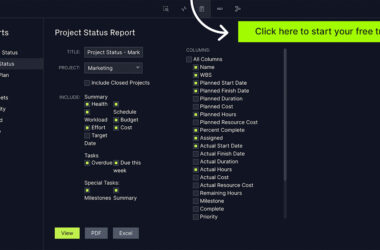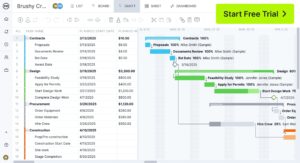We’ve had a great review of the strategic benefits, and hard and soft cost saving that you need to consider for your justification and/or business case in our recent post, Justifying A PPM Investment. But, how do we ensure that you are talking about the right benefits to the right stakeholders? Keep reading to learn how tailoring your stakeholder justification messages when investing in a project portfolio management system.
Let’s get started and begin by defining our stakeholders – Who are they? We’re going to categorize common stakeholders into 3 groups: Finance, HR/Resource Management and Executives.
We can’t stress enough how important it is for you to tailor your message! Messages that don’t resonate with a particular stakeholder group will be just noise and potentially defocus the message.
We like to call this the ‘Rabbit Hole of Details,’ and it can really throw you off track, especially with busy executives who might not be up to speed on the process. Wrong, questionable, or too much data distracts from the high-level conversation you planned to have. So start broad, and then zero-in on specifics. And we always recommend that you keep a few “just in case” slides in your back pocket.
Finance
One of our favorite conversations is talking to the Finance team. If you can provide direct benefit to the finance team, if you can make their lives easier and give them more accurate financials, or if you’re able to put their financials in your projects more accurately, faster, and with less administrative overhead, the finance team has a lot of sway in funding your projects.
We suggest tailoring your messages by adding:
IMPROVED PROJECT BUDGET MANAGEMENT, ESPECIALLY FOR FORECASTING
Anything where you can demonstrate the ability to have improved project budget management. Especially for forecasting. Now, if you’re in Professional Services, this is number one. This, in itself, will sell your PPM investment, if you can demonstrate that your forecasting is going to be more timely, and more responsive, and most importantly, more accurate.
DATA ACCURACY AND TRANSPARENCY
Of course, data accuracy and transparency are very important, being able to provide direct access into the PPM so they can see what the forecasts are, and also to keep the PMs in the loop in real-time. And, or course, more accurate data is vital, which brings us back around to…
AUTOMATION AND SIMPLIFICATION STANCE
Automation and simplification stance. Flipping that back around to the project managers, they’re going to be able to forecast and manage their projects better if they can get direct access into financials. So if we can automate bringing in financial data, your actual resource costs, your actual invoices for each item you’re spending money on, even timesheets or travel expenses, if you can get those into your PPM, it gives your project managers the power to make accurate forecasts, and helps you avoid a lot of firefighting. And this brings us back to our Single Source of Truth – the more you can automate, the more work you can do in a single system, the more accurate your data will be, and the easier it is on everyone. These are the kinds of benefits from a tool that really can help sell it!
Bottom line: If you can give Finance assurance that they’re going to get better financial data, more accurate forecasts, and more timely information, this puts you in a good position to justify the expenditure. Heck, they may just buy it for you.
HR & Resource Management
Next up is tailoring your messaging to your HR/Resource Management stakeholders.
From an HR/RM perspective, we want to think about Resource alignment. It’s really important to know what your resources are working on, what they’re doing: are they working on something important to your business i.e. your strategic initiatives? Are they improving quality, or reducing cost? We want our resources working on the projects that will provide the maximum value to the company, both short term and long term.
The reason we need to prioritize these projects is because resources only have so many hours. In our 2018 whitepaper, we saw that reliable and accurate project data correlates with a 62% improvement in resource utilization and project success. How many hours should resources be spending on new work vs. business–as–usual? What percentage do we want going towards various initiatives? Resource Managers need to know when they are over–or under-utilized, and they need to know before it hits crisis mode, and before company or customer expectations are set.
Of course, when we say ‘resources’, we actually mean ‘people’. And when working with people, team satisfaction is key.
Using multiple tools, double- or even triple-reporting data, and spending hours each week manually creating slide reports – it is mind–numbing. It’s not fun to do on a Friday night before you can go home. Having all your data in a single source makes everyone’s job easier. Clarizen, for example, has Slide Publisher and Document Publisher, which allows you to create status reports with the click of a button. That leaves more time to do more valuable work, to do professional development, … and lets you can clock out on time on Fridays.
That leads, again, into Automation and Simplification. A good PPM tool will have workflows, and scheduled workflows. Maybe the system will automatically send my status report out every week. Maybe I can log in and see at a glance which of my direct reports haven’t done their timesheets this week, and, with the click of a button, send them an email so they can update their time right from their inbox. Which ties back into team satisfaction, data accuracy and transparency, etc.
Bottom line: Human Resources/Resource Management wants to know what people are working on and that they have the proper balance of capacity to support initiatives that are important to the business.
What about headcount justification?
If you’re looking at your portfolio and you’ve got strategic initiatives coming down, and you’re at capacity, but these things are really important. Does that give me justification to add headcount? Or should I be reallocating people from, say, business-as-usual work, to more innovative projects. Your PPM will help you collect and evaluate that data, and then use it to justify those kinds of changes.
We’ve seen this used as a powerful tool to help build coalition with other managers. If you can get the light to go on, that, “This is a tool that can help you justify headcount.” Instead of saying, “We’re really busy, we need more people,” you can say, “For the new initiatives you’re asking for, I’ll need a 10% increase in staff to meet those requirements.”
The justification’s really easy to see in nice-looking graphs on a portfolio planning screen with hard data backing it up, vs just saying ‘Believe me.’
Executive Stakeholders
A group that especially needs a precise, tailored business case are your Executive stakeholders. We talked about a lot of these benefits early on, because pretty much everything we’ve talked about touches the C-Suite in some way. And that’s a lot of information for very busy people. When you talk to them, you have the opportunity to assure them that what you’re doing is aligned to their executive strategy. Have that conversation. How are they measuring that alignment, and how can we ensure we’re meeting that, as a department and as a company. And that’s what this tool can do, and that will be the story that you can teach them. Help them understand that you have a common goal.
And that’s the other thing. Your organization now isn’t the same organization it’s going to be a month from now, a quarter from now, a year from now. You’re always going to changing. Just look at that’s happened this year, you can’t foresee that. And we’re seeing a lot of businesses panicking, and just reacting because, well, ‘we have to do something.’ You have to be able to change, and to change smart. Your tool might need to change, to start incorporating new data or new business processes.
Justify your tool as giving you the data you need to justify a sound business decision, very quickly, and on the fly.
- Project alignment with Strategy
- Organizational Agility
- Automation and Simplification:
- Elimination of other systems ($$$$’s)
- Time to Market
- Delivery Quality / Project Success
- Lessons Learned
- Team / Customer / Stakeholder Satisfaction
- Data quality and timeliness
The post Tailoring Your Stakeholder Justification Messages When Investing In A Project Portfolio Management System appeared first on Kolme Group.





